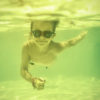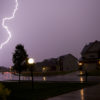Swimming Pool Safety: Overcoming Fear of the Water Saves Lives
If you or members of your family have a fear of water, it is important that this phobia be understood and overcome. Because drowning is a possibility in the residential swimming pool, learning to love the water and not be afraid of it is of utmost importance. Pool Troopers would like to share some information regarding safety and overcoming the fear of water that is being used in swimming instruction today. According to an article in Psychology Today, two-thirds of Americans have a fear of open water and 46% are afraid of the deep end of the pool. When it comes to swimming, 37% of Americans cannot swim; statistics show that almost 4000 people per year die of drowning. These facts are important when considering that fear of the water is a major issue for many adults and children. So how can fear of the water be addressed and successfully overcome?
Establishing trust is important
A very recent approach to this fear is to address the anxiety first, even before the pool has been entered. By establishing trust and listening to concerns, it is easier for the student to enter the pool. Some students may feel the flight or fight response when entering the swimming pool. Saying that, “there is nothing to be afraid of” does not really soothe their fears. A better reaction might be to make water less of a mystery by explaining its properties, such as buoyancy and what happens when you are in it, and it goes over and under you. Going slow is the key to establishing trust; the fear of water can be overcome. Ease of being in the water, rather than strokes is the first step in saving lives by overcoming fears that can lead to drowning. Relaxation techniques and visualization have been used towards this end; many of the exercises are practiced while being out of the water. According to Patty Chang Anker in the Psychology Today article, triathletes use “swim angels” because, “When you get scared you forget what you know. Teaching people what to do when they feel fear is about the most empowering antidote.”
Overcoming the fear of swimming
Swimming.org has some suggestions about for dealing with the fear of water in a beginning swim class. These include:
- Get feet wet first, gradually going deeper
- When you are deep enough, splash water on your face, as if you were washing it.
- Hold your breath underwater and blow bubbles
- Holding the side of the pool, practice kicking
- Slow down and don’t feel rushed
When you first step into the water, after your feet are wet, walk around in it for a while to enjoy the sensation of water. Once you feel comfortable in walking, it is time to proceed to splashing water on your face. When splashing water on your face, think positive thoughts and happy experiences. Realize that you are not alone and that people of all ages may have a fear of water. Both children and adults experience this fear and can set a goal of overcoming it.
More tips
Learning to float may be the key to water safety. Lay on your back while holding onto the sides of the pool with both hands. Remove one hand and try to hold on with only one. Then remove it, practicing several times until you are comfortable floating independently. Learning how to float will make you more comfortable in the water. Getting comfortable in the water is the first step in overcoming fear. If this includes standing in ankle-deep water and using visualization, that is a great first step. Focus on the goal while getting comfortable around the water in the pool.
Adult swim fears
Since most people believe that if you’re afraid of water, you just need to learn to swim, adults are being taught as if they were children. Conquer Your Fear of Water: An Innovative Self-Discovery Course in Swimming, written by longtime competitive swimmer and Miracle Swimming Institute founder Melon Dash, approaches it a different way. The Miracle Swimming Institute is located in Sarasota, Florida and has locations throughout the country. A recent article in Athletic Business highlighted this Institute’s role in helping adults overcome their fear of water. Because fear can make itself known in adults from 20 to 60 and above, Miracle Institute teaches that if you want to learn to swim, you must overcome your fear first. Rather than teaching strokes to the beginning swimmer, they teach people how to be comfortable in the water, how to remain in control and prevent panic and how the water works with the body. Some of this can be learned at home with a book, even before the water is entered.
Water safety
The American Red Cross has issued some suggestions regarding water safety, even for those who think they can swim. Their suggestion is to have swim lessons that are age appropriate. Lessons can be given to babies as young as six months as well as adults. Some of the Red Cross tips, as applied to a home swimming pool include:
- Swim with an adult nearby
- Swim with a buddy, even at a public pool
- Everyone in a family should know how to swim well
- Never leave a child unattended, and teach a child to ask permission to go in the water
- Young children and inexperienced swimmers should wear life jackets, but they should not be relied upon
The Red Cross suggests that limits be set and enforced, according to each swimmer’s ability. This includes safety measures such as:
- No playing around drains and suction fittings
- No breath holding contests
- No hyperventilating before swimming underwater
Alcohol should be not be consumed around water, as it impairs swimming and reduces the body’s ability to stay warm.
Pool safety measures to keep children safe
Pool Troopers wants your pool to be as safe as possible; to prevent access to the water that is not supervised, the Red Cross has suggested the following to use around pools and hot tubs:
- Install barriers around the swimming pool or hot tub
- Install safety covers and pool alarms
- Barriers should enclose the entire pool area and be at least 4-feet high
- Gates should be self-closing and self-latching and open outward, away from the pool
- Latches should be high enough to be out of reach for small children
- Above ground pools should have ladders removed when not in use; safety covers should be used
- Remove objects that provide access to the pool area, such as outdoor furniture, trees to climb, playground equipment, etc.
- Remove toys from pool area after use; toys can attract young children to the pool who are looking to play
The Red Cross suggests always staying at arm’s reach when supervising children in the pool. Distractions, such as cell phone viewing and texting, should be avoided when young children are in the water.
Safety equipment, such as throwing equipment, a cell phone, life jackets and a first aid kit should be available at poolside for the residential swimming pool. Emergency phone numbers should be easy to use.
Pool Troopers wants you and your family to be safe. Overcoming the fear of the water can save a life; having the right equipment and a pool that is in good condition can also lead to better safety. Wobbly ladders and other repairs should be done in a timely manner, before they become worse. At Pool Troopers, we can repair issues that could become safety hazards. Additionally, when it comes to having a pool that is clean and free of harmful bacteria, we can help you with our maintenance service.
Ensuring that the water is safe for swimming and that everyone in the family knows how to swim are wise steps to take towards the goal of a safe and fun pool environment. If you have some concerns about the condition of your pool or want to begin service, give Pool Troopers a call to schedule an appointment. When it comes to pool maintenance and repair, we’ve got your back.




